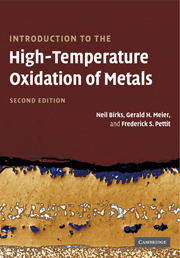Book contents
- Frontmatter
- Contents
- Acknowledgements
- Preface
- Introduction
- 1 Methods of investigation
- 2 Thermodynamic fundamentals
- 3 Mechanisms of oxidation
- 4 Oxidation of pure metals
- 5 Oxidation of alloys
- 6 Oxidation in oxidants other than oxygen
- 7 Reactions of metals in mixed environments
- 8 Hot corrosion
- 9 Erosion–corrosion of metals in oxidizing atmospheres
- 10 Protective coatings
- 11 Atmosphere control for the protection of metals during production processes
- Appendix A Solution to Fick's second law for a semi-infinite solid
- Appendix B Rigorous derivation of the kinetics of internal oxidation
- Appendix C Effects of impurities on oxide defect structures
- Index
- References
5 - Oxidation of alloys
Published online by Cambridge University Press: 05 June 2012
- Frontmatter
- Contents
- Acknowledgements
- Preface
- Introduction
- 1 Methods of investigation
- 2 Thermodynamic fundamentals
- 3 Mechanisms of oxidation
- 4 Oxidation of pure metals
- 5 Oxidation of alloys
- 6 Oxidation in oxidants other than oxygen
- 7 Reactions of metals in mixed environments
- 8 Hot corrosion
- 9 Erosion–corrosion of metals in oxidizing atmospheres
- 10 Protective coatings
- 11 Atmosphere control for the protection of metals during production processes
- Appendix A Solution to Fick's second law for a semi-infinite solid
- Appendix B Rigorous derivation of the kinetics of internal oxidation
- Appendix C Effects of impurities on oxide defect structures
- Index
- References
Summary
Introduction
Many of the factors described for the oxidation of pure metals also apply to the oxidation of alloys. However, alloy oxidation is generally much more complex as a result of some, or all, of the following.
The metals in the alloy will have different affinities for oxygen reflected by the different free energies of formation of the oxides.
Ternary and higher oxides may be formed.
A degree of solid solubility may exist between the oxides.
The various metal ions will have different mobilities in the oxide phases.
The various metals will have different diffusivities in the alloy.
Dissolution of oxygen into the alloy may result in sub-surface precipitation of oxides of one or more alloying elements (internal oxidation).
This chapter describes the major effects occurring in alloy oxidation and their relation to the above factors. No attempt has been made to provide a complete survey of the extensive literature on this subject, rather, examples which illustrate the important fundamentals are presented. This is done by first classifying the types of reactions which occur, and then describing additional factors which have significant influences on the oxidation process. Subsequent chapters will describe the oxidation of alloys in complex environments, such as those involving mixed gases, liquid deposits, and erosive conditions and the use of coatings for oxidation protection. Previous reviews of alloy oxidation include those by Kubaschewski and Hopkins, Hauffe, Benard, Pfeiffer and Thomas, Birchenall, Mrowec and Werber, Kofstad, and Beranger, Colson and Dabosi.
Information
- Type
- Chapter
- Information
- Introduction to the High Temperature Oxidation of Metals , pp. 101 - 162Publisher: Cambridge University PressPrint publication year: 2006
References
Accessibility standard: Unknown
Why this information is here
This section outlines the accessibility features of this content - including support for screen readers, full keyboard navigation and high-contrast display options. This may not be relevant for you.Accessibility Information
- 15
- Cited by
